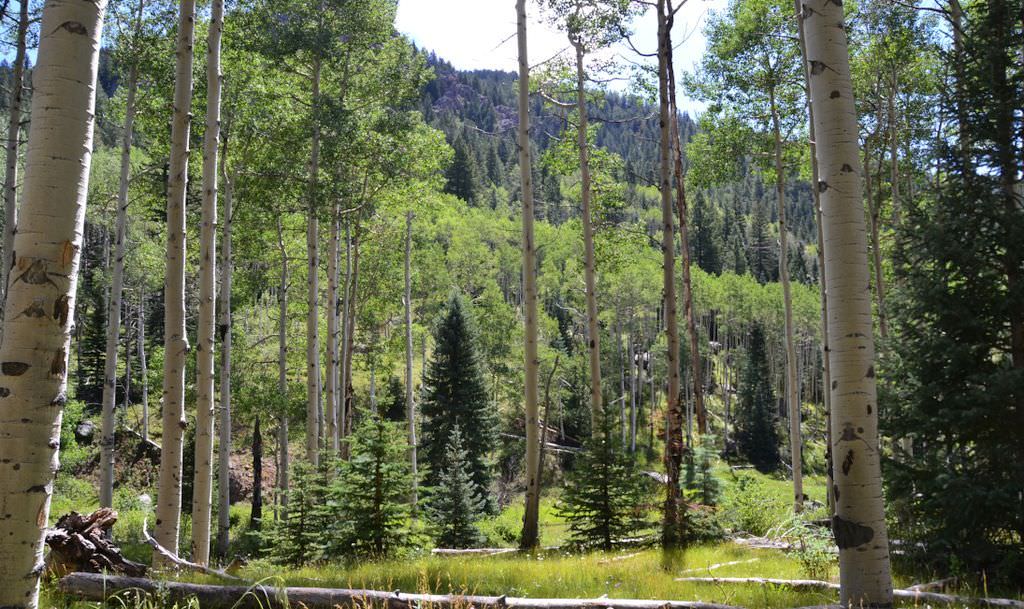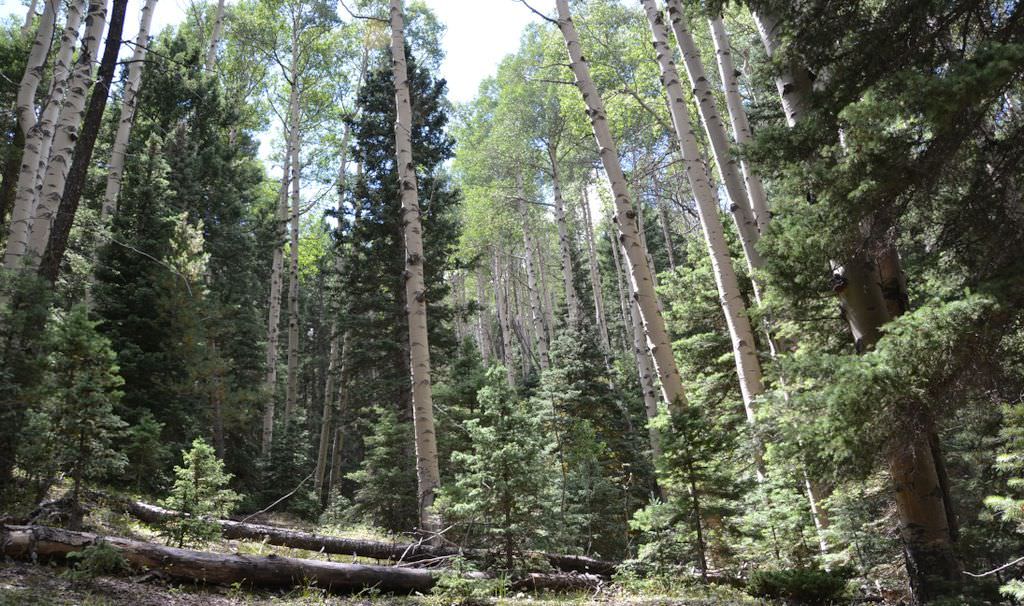Inter-Mountain Basins Aspen-Mixed Conifer Forest and Woodland
Click link below for details.
General Description
This widespread ecological system occurs on montane slopes and plateaus from northern Arizona and New Mexico through eastern Nevada, Utah, and Colorado, and north into western Wyoming, and southern Idaho and Montana. In Colorado, these are mixed forests and woodlands of drier areas than those supporting extensive pure aspen forests, especially east of the Continental Divide. Elevations are similar to those of aspen or mixed conifer forests, ranging from about 2,290 to 3,350 m (7,500 to 11,000 ft). The tree canopy is composed of a mix of deciduous and coniferous species, codominated by quaking aspen (Populus tremuloides) and various conifers that may include Douglas fir (Pseudotsuga menziesii), ponderosa pine (Pinus ponderosa) white fir (Abies concolor), blue spruce (Picea pungens), lodgepole pine (Pinus contorta), subalpine fir (Abies lasiocarpa), or Engelmann spruce (Picea engelmannii), depending on elevation. In places aspen may be locally dominant, but surrounded by mixed coniferous stands. As an occurrence ages, aspen is often slowly reduced until the conifer species become dominant. Understories may be shrub or herbaceous dominated. Common shrubs include Saskatoon serviceberry (Amelanchier alnifolia), Rocky Mountain maple (Acer glabrum), mountain ninebark (Physocarpus monogynus), mountain snowberry (Symphoricarpos oreophilus), common juniper (Juniperus communis), Oregon boxleaf (Paxistima myrsinites), Woods' rose (Rosa woodsii), or creeping barberry (Mahonia repens). Herbaceous species include fringed brome (Bromus ciliatus), bluejoint (Calamagrostis canadensis), Geyer's sedge (Carex geyeri), oatgrass (Danthonia spp.), blue wildrye (Elymus glaucus), Thurber fescue (Festuca thurberi) needle-and-thread (Hesperostipa comata), green needlegrass (Nassella viridula), western yarrow (Achillea millefolium var. occidentalis), heartleaf arnica (Arnica cordifolia), Indian paintbrush (Castilleja spp.), fleabane (Erigeron spp.), northern bedstraw (Galium boreale), silvery lupine (Lupinus argenteus), and many other forbs.
Diagnostic Characteristics
These mixed forests are characterized by a canopy where aspen is dominant or co-dominant, but with a variety of conifer species also present. These are successional forests; in the absence of stand-replacing disturbance, conifers will eventually replace aspen as dominant in the canopy.
Similar Systems
Southern Rocky Mountain Dry-Mesic Montane Mixed Conifer Forest and Woodland: Mixed conifer forests and woodland can be difficult to distinguish from the aspen-mixed conifer type. In general, if aspen is present in small patches rather than co-dominant, occurrences should be considered as belonging to the mixed conifer type. Both this and the pure aspen forest are likely to intergrade in many areas with the aspen-mixed conifer system.
Range
The Inter-Mountain Basins Aspen-Mixed Conifer Forest and Woodland system occurs on montane slopes and plateaus from northern Arizona and New Mexico through eastern Nevada, Utah, and Colorado, and north into western Wyoming, and southern Idaho and Montana. Colorado occurrences are found throughout the mountainous portion of the state at elevations of 2,290 to 3,350 m (7,500 to 11,000 ft), but are most common on the east slope.
Ecological System Distribution

Spatial Pattern
In Colorado, Inter-Mountain Basins Aspen-Mixed Conifer Forest and Woodland is probably generally found as a large patch, but may also occur in a matrix with aspen forests and mixed conifer forests.
Environment
Occurrences occupy similar environments, and are often intermixed with mixed-conifer or aspen forests. Local conditions, biogeographic history, and competitive interactions over many decades are prime determinants of stand composition. Sites may be dry or mesic, but are generally at montane to subalpine elevations where annual precipitation exceeds evapotranspiration. The lower elevational limit of aspen growth coincides with a mean annual temperature of about 7°C. Occurrences are found on a variety of slopes and aspects, and soils are variable but with sufficient moisture availability to support forest growth. Well-drained, shallow soils will support more open stands.
Vegetation
The tree canopy is composed of a mix of deciduous and coniferous species, codominated by quaking aspen (Populus tremuloides) and various conifers that may include Douglas fir (Pseudotsuga menziesii), ponderosa pine (Pinus ponderosa) white fir (Abies concolor), blue spruce (Picea pungens), lodgepole pine (Pinus contorta), subalpine fir (Abies lasiocarpa), or Engelmann spruce (Picea engelmannii), depending on elevation. Understories may be shrub or herbaceous dominated. Common shrubs include Saskatoon serviceberry (Amelanchier alnifolia), Rocky Mountain maple (Acer glabrum), mountain ninebark (Physocarpus monogynus), mountain snowberry (Symphoricarpos oreophilus), common juniper (Juniperus communis), Oregon boxleaf (Paxistima myrsinites), Woods' rose (Rosa woodsii), or creeping barberry (Mahonia repens). Herbaceous species include fringed brome (Bromus ciliatus), bluejoint (Calamagrostis canadensis), Geyer's sedge (Carex geyeri), oatgrass (Danthonia spp.), blue wildrye (Elymus glaucus), Thurber fescue (Festuca thurberi) needle-and-thread (Hesperostipa comata), green needlegrass (Nassella viridula), western yarrow (Achillea millefolium var. occidentalis), heartleaf arnica (Arnica cordifolia), Indian paintbrush (Castilleja spp.), fleabane (Erigeron spp.), northern bedstraw (Galium boreale), silvery lupine (Lupinus argenteus), and many other forbs.
- CEGL000527 Populus tremuloides - Abies lasiocarpa / Juniperus communis Forest
- CEGL000529 Populus tremuloides - Abies lasiocarpa / Shepherdia canadensis Forest
- CEGL000535 Populus tremuloides - Picea pungens Forest
- CEGL000537 Populus tremuloides - Pinus contorta / Juniperus communis Forest
- CEGL000540 Populus tremuloides - Pinus flexilis Forest
- CEGL000541 Populus tremuloides - Pinus ponderosa Rocky Mountain Forest
- CEGL000543 Populus tremuloides - Pseudotsuga menziesii / Amelanchier alnifolia Forest
- CEGL000545 Populus tremuloides - Pseudotsuga menziesii / Juniperus communis Forest
Associated Animal Species
These mixed forests provide habitat for many mammal species, including mountain lion (Felis concolor), bobcat (Felis rufus), black bear (Ursus americanus), short-tailed weasel (Mustela erminea), mule deer (Odocoileus hemionus), elk (Cervus elaphus), golden-mantled ground squirrel (Callospermophilus lateralis), chipmunks (Neotamias spp.). A variety of forest birds in these habitats include Northern Goshawk (Accipiter gentilis), Cooper's Hawk (Accipiter cooperii), Sharp-shinned Hawk (Accipiter striatus), Hairy Woodpecker (Dryobates villosus), Steller's Jay (Cyanocitta stelleri), Dusky Grouse (Dendragapus obscurus), Black-capped Chickadee (Poecile atricapillus), Mountain Chickadee (Poecile gambeli), Cassin's Sparrow (Peucaea cassinii), Dark-eyed Junco (Junco hyemalis), Hermit Thrush (Catharus guttatus), Pine Siskin (Spinus pinus), and House Wren (Troglodytes aedon).
Dynamic Processes
Although aspen is not fire tolerant, it is highly competitive in burned areas if other conditions are suitable. Aspen clones can survive in the understory of cool, moist mixed conifer and low elevation spruce-fir, and can respond quickly to disturbances. Even when stands are severely burned, aspen often resprouts. Because aspen is considered an early-seral species characteristic of disturbance, most occurrences of this forest type are thought to represent instances of conifers succeeding to aspen. An occurrence may originate after a large, stand-replacing disturbance such as crown fire, disease outbreak, windthrow, or clearcutting. Aspen is extremely shade intolerant, and will eventually be replaced by conifer species that sprout in the understory. Fire suppression in particular, as well as livestock grazing and the elimination of predators on large ungulates have apparently increased the reproductive success of shade-tolerant conifers in aspen stands, resulting in these mixed forest and woodland stands. The fact that processes operating prior to European settlement have not returned to historic patterns has made it difficult to predict the future trajectory of this and the associated forest types.
Management
Aspen-mixed conifer forests in Colorado are generally in good condition, especially in areas where they are more remote from the wildland-urban interface. In areas of exurban development fire suppression will continue to be a factor in the changing composition of these forests and woodlands. In some areas extensive removal of beetle-killed conifers may allow expansion of this system, especially the aspen component. Livestock grazing, and grazing by large ungulates can suppress the aspen component of these forests, but is likely to be less of a factor than in the past. Changing climate conditions are likely to alter the relative dominance of overstory species, overall species composition and relative cover, primarily through the action of fire, insect outbreak, and drought. Drought and disturbance tolerant species will be favored over drought vulnerable species. The higher biodiversity in overstory species may allow these forests and woodlands to adapt to changing climate, even in the face of potential increases in area burned.
References
- Bartos, D.L. 2001. Landscape dynamics of aspen and conifer forests. Pages 5-14 in: W.D. Shepperd, D. Binkley, D.L. Bartos, T.J. Stohlgren, and L.G. Eskew, compilers. Sustaining aspen in western landscapes: Symposium proceedings; 13-15 June 2000. Grand Junction, CO. Proceedings RMRS-P-18. USDA Forest Service, Rocky Mountain Research Station, Fort Collins, Colorado.
- Mueggler, W.F. 1988. Aspen Community Types of the Intermountain Region. USDA Forest Service. INT-250.
- Perala, D.A. 1990. Populus tremuloides Michx. quaking aspen. Pp 555-569 In: Burns, Russell M.; Honkala, Barbara H., technical coordinators. Silvics of North America: Volume 2, Hardwoods. Agriculture Handbook 654. Washington, DC: U.S. Department of Agriculture, Forest Service. Pepin, D.









